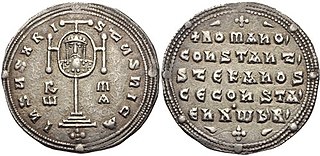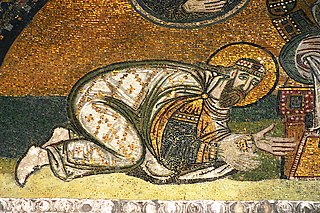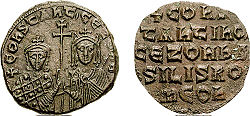
Year 913 (CMXIII) was a common year starting on Friday of the Julian calendar.

Nicholas I Mystikos or Nicholas I Mysticus was the Ecumenical Patriarch of Constantinople from March 901 to February 907 and from May 912 to his death in 925. His feast day in the Eastern Orthodox Church is 16 May.

Romanos I Lekapenos or Lakapenos, Latinized as Romanus I Lecapenus, was an Armenian who became a Byzantine naval commander and reigned as Byzantine Emperor from 920 until his deposition on December 16, 944.
This is a list of people, places, things, and concepts related to or originating from the Byzantine Empire. Feel free to add more, and create missing pages. You can track changes to the articles included in this list from here.

Zoe Karbonopsina, also Karvounopsina or Carbonopsina, i.e., "with the Coal-Black Eyes", was an empress consort and regent of the Byzantine empire. She was the fourth spouse of the Byzantine Emperor Leo VI the Wise and the mother of Constantine VII, serving as his regent from 914 until 919.
Leo Phokas was an early 10th-century Byzantine general of the noble Phokas clan. As Domestic of the Schools, the Byzantine army's commander-in-chief, he led a large-scale campaign against the Bulgarians in 917, but was heavily defeated at the battles of Acheloos and Katasyrtai. He then plotted to seize the throne from the young Byzantine emperor Constantine VII, but was outmaneuvered by the admiral Romanos Lekapenos, who managed to become guardian and later father-in-law of the Emperor. After Lekapenos seized control of the Byzantine Empire, Leo led an unsuccessful revolt, and was captured and blinded.

Euthymius I Syncellus was the Ecumenical Patriarch of Constantinople from 907 to 912. A monk since his youth, he became spiritual father of the future emperor Leo VI the Wise, and was raised by him to the high ecclesiastical office of syncellus. Despite his turbulent relationship with Leo, in 907 he was appointed to the patriarchate and held the post until his deposition shortly before or after Leo's death in 912.
Andronikos Doukas or Doux was a Byzantine general and rebel in the reign of Emperor Leo VI the Wise. The first member of the illustrious Doukas line to achieve prominence as a successful general, his rivalry with the powerful eunuch Samonas led to his revolt and eventual defection to the Arabs in 906–907. He died in exile in Baghdad.
Constantine Doukas was a prominent Byzantine general. In 904, he stopped the influential eunuch court official Samonas from defecting to the Arabs. In return, Samonas manipulated his father, Andronikos Doukas, into rebelling and fleeing to the Abbasid court in 906/7. Constantine followed his father to Baghdad, but soon escaped and returned to Byzantium, where he was restored by Leo VI the Wise to favour and entrusted with high military offices. Upon the death of the Emperor Alexander, Constantine with the support of several aristocrats unsuccessfully tried to usurp the throne from the young Constantine VII, but was killed in a clash with supporters of the legitimate emperor.
Leo Choirosphaktes, sometimes Latinized as Choerosphactes and also known as Leo Magistros or Leo Magister, was a Byzantine official who rose to high office under Emperor Basil I the Macedonian and served as an envoy under Emperor Leo VI the Wise to Bulgaria and the Abbasid Caliphate. Choirosphaktes was also a well-educated and prominent scholar and writer, many of whose works and correspondence survive.
John Garidas was a Byzantine military officer who played an important role in the court politics of the early 10th century.
John Mystikos was a Byzantine official, who served as the chief minister (paradynasteuon) of the empire in the early reign of Romanos I Lekapenos. After being suspected of designs on the throne, he was deposed and sent to exile in a monastery. He eventually recovered a place at court, leading a three-year mission abroad in the 930s, and apparently regained his former high position with the rise of Constantine VII Porphyrogennetos to sole rule in 945. He is last mentioned as leading an embassy to Muhammad ibn Tughj al-Ikhshid in 946.
The Byzantine–Bulgarian war of 913–927 was fought between the Bulgarian Empire and the Byzantine Empire for more than a decade. Although the war was provoked by the Byzantine emperor Alexander's decision to discontinue paying an annual tribute to Bulgaria, the military and ideological initiative was held by Simeon I of Bulgaria, who demanded to be recognized as Tsar and made it clear that he aimed to conquer not only Constantinople but the rest of the Byzantine Empire, as well.
Gregoras Iberitzes was a Byzantine nobleman and senior military leader of the early 10th century.
Constantine (Greek: Κωνσταντῖνος, surnamed Barbaros, was a Byzantine eunuch servant who rose to become parakoimomenos of the Byzantine emperor Leo VI the Wise in 911–912, displacing his own former master, Samonas. He held again the post during the regency of Zoe Karbonopsina in 913–919, where he played an important role in the governance of the state. He lost his post after he supported his relative Leo Phokas the Elder in his unsuccessful rivalry with Romanos I Lekapenos over control of the throne, but he was later appointed to the post of primikerios by Lekapenos.
The Battle of Constantinople was fought in June 922 at the outskirts of the capital of the Byzantine Empire, Constantinople, between the forces of the First Bulgarian Empire and the Byzantines during the Byzantine–Bulgarian war of 913–927. In the summer the Byzantine Emperor Romanos I Lekapenos sent troops under the commander Saktikios to repel another Bulgarian raid at the outskirts of the Byzantine capital. The Byzantines stormed the Bulgarian camp but were defeated when they confronted the main Bulgarian forces. During his flight from the battlefield Saktikios was mortally wounded and died the following night.











